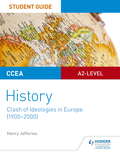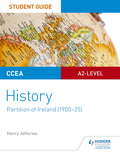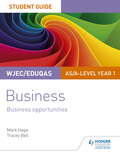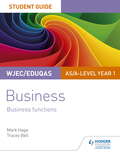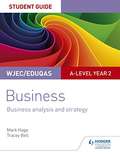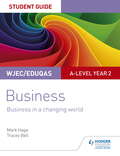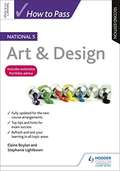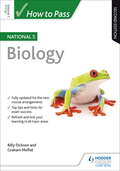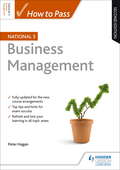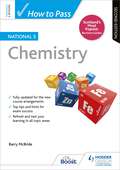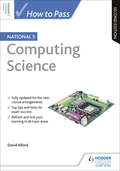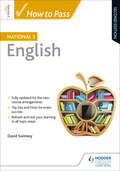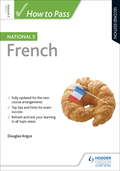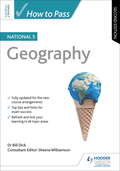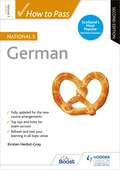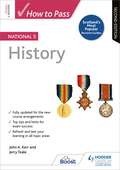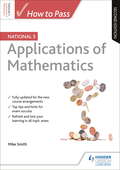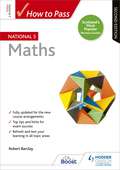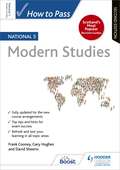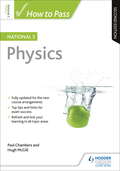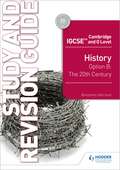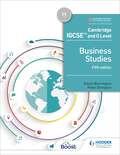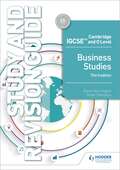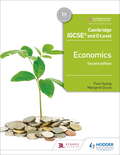- Table View
- List View
CCEA A2-level History Student Guide: Clash of Ideologies in Europe (1900-2000)
by Henry JefferiesBuild, reinforce and assess students' knowledge throughout their course; tailored to the 2016 CCEA specification and brought to you by the leading History publisher, this study and revision guide combines clear content coverage with practice questions and sample answers.- Ensure understanding of the period with concise coverage of all Unit content, broken down into manageable chunks- Develop the analytical and evaluative skills that students need to succeed in A-level History- Consolidate understanding with exam tips and knowledge-check questions- Practise exam-style questions matched to the CCEA assessment requirements for every question type- Improve students' exam technique and show them how to reach the next grade with sample student answers and commentary for each exam-style question- Use flexibly in class or at home, for knowledge acquisition during the course or focused revision and exam preparation
CCEA A2-level History Student Guide: Partition of Ireland (1900-25)
by Henry JefferiesBuild, reinforce and assess students' knowledge throughout their course; tailored to the 2016 CCEA specification and brought to you by the leading History publisher, this study and revision guide combines clear content coverage with practice questions and sample answers.- Ensure understanding of the period with concise coverage of all Unit content, broken down into manageable chunks- Develop the analytical and evaluative skills that students need to succeed in A-level History- Consolidate understanding with exam tips and knowledge-check questions- Practise exam-style questions matched to the CCEA assessment requirements for every question type, including source-based examples- Improve students' exam technique and show them how to reach the next grade with sample student answers and commentary for each exam-style question- Use flexibly in class or at home, for knowledge acquisition during the course or focused revision and exam preparation
WJEC/Eduqas AS/A-level Year 1 Business Student Guide 1: Business Op Epub
by Mark Hage Tracey BellBuild, reinforce and assess students' knowledge throughout their course; tailored to the 2015 WJEC and WJEC Eduqas specifications and brought to you by the leading A-level Business publisher, these study and revision guides combine clear content coverage with practice questions and sample answers.- Ensure understanding with concise coverage of each topic, broken down into manageable chunks- Help students apply their knowledge to up-to-date examples that cover key content areas such as technology and globalisation- Consolidate understanding with exam tips and knowledge-check questions- Practise exam-style questions for every question type, with plenty of opportunities to develop the maths and quantitative skills that students need to succeed- Improve students' exam technique and show them how to reach the next grade using sample student answers and commentary for each exam-style question- Use flexibly in class or at home, for knowledge acquisition during the course or focused revision and exam preparation
WJEC/Eduqas AS/A-level Year 1 Business Student Guide 2: Bus Func Epub
by Mark Hage Tracey BellExam boards: WJEC and WJEC EduqasLevel: AS/A-levelSubject: BusinessFirst teaching: September 2015First exams: Summer 2016 (AS); Summer 2017 (A-level)Build, reinforce and assess students' knowledge throughout the course. Tailored to the 2015 WJEC and Eduqas specifications and brought to you by the leading A-level Business publisher, this study and revision guide combines clear content coverage with practice questions and sample answers.- Ensure understanding with concise coverage of each topic, broken down into manageable chunks- Help students apply their knowledge to up-to-date examples that cover key content areas such as technology- Consolidate understanding with exam tips and knowledge-check questions- Practise exam-style questions for every question type, with plenty of opportunities to develop the maths and quantitative skills that students need to succeed- Improve students' exam technique and show them how to reach the next grade using sample student answers and commentary for each exam-style question- Use flexibly in class or at home, for knowledge acquisition during the course or focused revision and exam preparationThis Student Guide covers the content of:- 2015 WJEC AS/A-level Business specifications regulated by Qualifications Wales- 2015 WJEC Eduqas AS/A-level Business specifications regulated by Ofqual
WJEC/Eduqas A-level Year 2 Business Student Guide 3: Bas
by Mark Hage Tracey BellExam boards: WJEC and WJEC EduqasLevel: AS/A-levelSubject: BusinessFirst teaching: September 2015First exams: Summer 2016 (AS); Summer 2017 (A-level)Build, reinforce and assess students' knowledge throughout the course. Tailored to the 2015 WJEC and Eduqas specifications and brought to you by the leading A-level Business publisher, this study and revision guide combines clear content coverage with practice questions and sample answers.- Ensure understanding with concise coverage of each topic, broken down into manageable chunks- Help students apply their knowledge to up-to-date examples that cover key content areas such as technology- Consolidate understanding with exam tips and knowledge-check questions- Practise exam-style questions for every question type, with plenty of opportunities to develop the maths and quantitative skills that students need to succeed- Improve students' exam technique and show them how to reach the next grade using sample student answers and commentary for each exam-style question- Use flexibly in class or at home, for knowledge acquisition during the course or focused revision and exam preparationThis Student Guide covers the content of:- 2015 WJEC AS/A-level Business specifications regulated by Qualifications Wales- 2015 WJEC Eduqas AS/A-level Business specifications regulated by Ofqual
WJEC/Eduqas A-level Year 2 Business Student Guide 4: Changing World Epub
by Mark Hage Tracey BellExam boards: WJEC and WJEC EduqasLevel: AS/A-levelSubject: BusinessFirst teaching: September 2015First exams: Summer 2016 (AS); Summer 2017 (A-level)Build, reinforce and assess students' knowledge throughout the course. Tailored to the 2015 WJEC and Eduqas specifications and brought to you by the leading A-level Business publisher, this study and revision guide combines clear content coverage with practice questions and sample answers.- Ensure understanding with concise coverage of each topic, broken down into manageable chunks- Help students apply their knowledge to up-to-date examples that cover key content areas such as technology and globalisation- Consolidate understanding with exam tips and knowledge-check questions- Practise exam-style questions for every question type, with plenty of opportunities to develop the maths and quantitative skills that students need to succeed- Improve students' exam technique and show them how to reach the next grade using sample student answers and commentary for each exam-style question- Use flexibly in class or at home, for knowledge acquisition during the course or focused revision and exam preparationThis Student Guide covers the content of:- 2015 WJEC AS/A-level Business specifications regulated by Qualifications Wales- 2015 WJEC Eduqas AS/A-level Business specifications regulated by Ofqual
How to Pass National 5 Art & Design: Second Edition
by Elaine Boylan Stephanie LightbownExam Board: SQALevel: National 5Subject: Art & DesignFirst Teaching: August 2017First Exam: May 2018Fully updated to account for the removal of Unit Assessments and the changes to the National 5 exam, this book contains all the advice and support you need to revise successfully. It combines an overview of the course syllabus with advice from top experts on how to improve exam performance, so you have the best chance of success.- Refresh your knowledge with complete course notes- Prepare for the exam with top tips and hints on revision technique- Get your best grade with advice on how to gain those vital extra marks
How to Pass National 5 Biology: Second Edition
by Graham Moffat Billy DicksonExam Board: SQALevel: National 5Subject: BiologyFirst Teaching: August 2017First Exam: May 2018Fully updated to account for the removal of Unit Assessments and the changes to the National 5 exam, this book contains all the advice and support you need to revise successfully. It combines an overview of the course syllabus with advice from top experts on how to improve exam performance, so you have the best chance of success.- Refresh your knowledge with complete course notes- Prepare for the exam with top tips and hints on revision technique- Get your best grade with advice on how to gain those vital extra marks
How to Pass National 5 Business Management: Second Edition
by Peter HaganExam Board: SQALevel: National 5Subject: BusinessFirst Teaching: August 2017First Exam: May 2018Get your best grade with the SQA endorsed guide to National 5 Business Management.Fully updated to account for the removal of Unit Assessments and the changes to the National 5 exam, this book contains all the advice and support you need to revise successfully. It combines an overview of the course syllabus with advice from a top expert on how to improve exam performance, so you have the best chance of success.- Refresh your knowledge with complete course notes- Prepare for the exam with top tips and hints on revision technique- Get your best grade with advice on how to gain those vital extra marks
How to Pass National 5 Chemistry, Second Edition: Second Edition
by Barry McBrideExam Board: SQALevel: National 5Subject: ChemistryFirst Teaching: September 2017First Exam: Summer 2018This book contains all the advice and support you need to revise successfully for your National 5 exam. It combines an overview of the course syllabus with advice from a top expert on how to improve exam performance, so you have the best chance of success.- Refresh your knowledge with complete course notes- Prepare for the exam with top tips and hints on revision technique- Get your best grade with advice on how to gain those vital extra marks
How to Pass National 5 Computing Science: Second Edition
by David AlfordExam Board: SQALevel: National 5Subject: Computing ScienceFirst Teaching: August 2017First Exam: May 2018Get your best grade with the SQA endorsed guide to National 5 Computing Science.Fully updated to account for the removal of Unit Assessments and the changes to the National 5 exam, this book contains all the advice and support you need to revise successfully. It combines an overview of the course syllabus with advice from a top expert on how to improve exam performance, so you have the best chance of success.- Refresh your knowledge with complete course notes- Prepare for the exam with top tips and hints on revision technique- Get your best grade with advice on how to gain those vital extra marks
How to Pass National 5 English: Second Edition
by David SwinneyExam Board: SQALevel: National 5Subject: EnglishFirst Teaching: August 2017First Exam: May 2018This book contains all the advice and support you need to revise successfully for your National 5 exam. It combines an overview of the course syllabus with advice from a top expert on how to improve exam performance, so you have the best chance of success.- Refresh your knowledge with complete course notes- Prepare for the exam with top tips and hints on revision technique- Get your best grade with advice on how to gain those vital extra marks
How to Pass National 5 French: Second Edition
by Douglas AngusExam Board: SQALevel: National 5Subject: FrenchFirst Teaching: August 2017First Exam: May 2018Get your best grade with the SQA endorsed guide to National 5 French.This book contains all the advice and support you need to revise successfully for your National 5 exam. It combines an overview of the course syllabus with advice from a top expert on how to improve exam performance, so you have the best chance of success.- Refresh your knowledge with complete course notes- Prepare for the exam with top tips and hints on revision technique- Get your best grade with advice on how to gain those vital extra marks
How to Pass National 5 Geography: Second Edition Ebook
by Bill Dick Sheena WilliamsonExam Board: SQALevel: National 5Subject: GeographyFirst Teaching: August 2017First Exam: May 2018Fully updated to account for the removal of Unit Assessments and the changes to the National 5 exam, this book contains all the advice and support you need to revise successfully. It combines an overview of the course syllabus with advice from top experts on how to improve exam performance, so you have the best chance of success.- Refresh your knowledge with complete course notes- Prepare for the exam with top tips and hints on revision technique- Get your best grade with advice on how to gain those vital extra marks
How to Pass National 5 German: Second Edition Ebook
by Kirsten Herbst-GrayGet your best grade with How to Pass National 5 German.Fully updated to account for the removal of Unit Assessments and the changes to the National 5 exam, this book contains all the advice and support you need to revise successfully. It combines an overview of the course syllabus with advice from a top expert on how to improve exam performance, so you have the best chance of success.- Refresh your knowledge with complete course notes- Prepare for the exam with top tips and hints on revision technique- Get your best grade with advice on how to gain those vital extra marks
How to Pass National 5 History: Second Edition Ebook
by John Kerr Jerry TealeExam Board: SQALevel: National 5Subject: HistoryFirst Teaching: September 2017First Exam: Summer 2018Fully updated to account for the removal of Unit Assessments and the changes to the National 5 exam, this book contains all the advice and support you need to revise successfully. It combines an overview of the course syllabus with advice from top experts on how to improve exam performance, so you have the best chance of success.- Refresh your knowledge with complete course notes- Prepare for the exam with top tips and hints on revision technique- Get your best grade with advice on how to gain those vital extra marks
How to Pass National 5 Applications of Maths: Second Edition Ebook
by Mike SmithExam Board: SQALevel: National 5Subject: MathsFirst Teaching: August 2017First Exam: May 2018Get your best grade with How to Pass National 5 Applications of Mathematics.Fully updated to account for the changes to the National 5 exam, this book contains all the advice and support you need to revise successfully. It combines an overview of the course syllabus with advice from a top expert on how to improve exam performance, so you have the best chance of success.- Refresh your knowledge with complete course notes- Prepare for the exam with top tips and hints on revision technique- Get your best grade with advice on how to gain those vital extra marks
How to Pass National 5 Maths, Second Edition: Second Edition Epub
by Robert BarclayExam Board: SQALevel: National 5Subject: MathsFirst teaching: September 2017First exams: Summer 2018Get your best grade with comprehensive course notes and advice from Scotland's top experts, fully updated for the latest changes to the National 5 course specification.How to Pass National 5 Maths, Second Edition contains all the advice and support you need to revise successfully for your National 5 exam. It combines an overview of the course syllabus with advice from a top expert on how to improve exam performance, so you have the best chance of success.> Revise confidently with up-to-date guidance tailored to the latest assessment changes> Refresh your knowledge with comprehensive, tailored subject notes> Prepare for the exam with top tips and hints on revision techniques> Get your best grade with advice on how to gain those vital extra marks
How to Pass National 5 Modern Studies: Second Edition Ebook
by Gary Hughes Frank Cooney David SheerinExam Board: SQALevel: National 5Subject: Modern StudiesFirst Teaching: August 2017First Exam: May 2018Fully updated to account for the removal of Unit Assessments and the changes to the National 5 exam, this book contains all the advice and support you need to revise successfully. It combines an overview of the course syllabus with advice from top experts on how to improve exam performance, so you have the best chance of success.- Refresh your knowledge with complete course notes- Prepare for the exam with top tips and hints on revision technique- Get your best grade with advice on how to gain those vital extra marks
How to Pass National 5 Physics: Second Edition Ebook
by Paul Chambers Hugh McGillExam Board: SQALevel: National 5Subject: PhysicsFirst Teaching: August 2017First Exam: May 2018Fully updated to account for the removal of Unit Assessments and the changes to the National 5 exam, this book contains all the advice and support you need to revise successfully. It combines an overview of the course syllabus with advice from top experts on how to improve exam performance, so you have the best chance of success.- Refresh your knowledge with complete course notes- Prepare for the exam with top tips and hints on revision technique- Get your best grade with advice on how to gain those vital extra marks
Cambridge IGCSE and O Level History Study and Revision Guide
by Benjamin HarrisonEnter the exam with the confidence to achieve your best grade using a concise summary of the syllabus content and step-by-step guidance in exam technique. - Target your revision on the issues, Key Questions and Focus Points- Build your history vocabulary with the Key words feature- Reinforce knowledge and skills learned with exam-style Practice questions and Model answers - Avoid common errors and aid preparation with Examiner's tips highlighting good practice.This Study and Revision Guide is designed for the examination from 2020. This title has not been through the Cambridge Assessment International Education endorsement process.Also available in this series:Student Textbook Second edition (ISBN 9781510421189)Student eTextbook (ISBN 9781510420045)Whiteboard eTextbook (ISBN 9781510420052)Online Teacher's Guide (ISBN 9781510424104)Workbook International Relations since 1919 (ISBN 9781510421202)Workbook Depth study: Russia, 1905-41 (ISBN 9781510448308)Workbook Depth study: Germany, 1918-45 (ISBN 9781510448575)Workbook Depth study: The United States, 1919-41 (ISBN 9781510448582)
Cambridge IGCSE and O Level Accounting
by June BaptistaThis title is endorsed by Cambridge Assessment International Education to support the full syllabus for examination from 2020.Develop accounting skills and apply knowledge to relevant business-related contexts with a Student's Book providing in-depth coverage of the latest Cambridge IGCSE and O Level Accounting syllabuses (0452/7707).- Trust an experienced author to navigate the syllabuses confidently with clearly-defined learning objectives throughout.- Deepen understanding by reflecting on how accounting shapes the wider business-related world with 'Think about it!' tasks. - Apply, analyse and reflect on knowledge with engaging activities integrating deep learning skills throughout. - Benefit from language support with an accessible text and definitions of technical terms.- Consolidate learning with chapter reviews and examination-style questions.Available in this series:Student Textbook (ISBN 9781510421219)Student and Whiteboard eTextbooks (ISBN 9781510420021 and ISBN 9781510420038)Workbook (ISBN 9781510421226)Online Teacher's Guide (ISBN 9781510424111)
Cambridge IGCSE and O Level Business Studies 5th edition
by Karen Borrington Peter StimpsonExam board: Cambridge Assessment International EducationLevel: IGCSESubject: Business StudiesFirst teaching: September 2018First exams: Summer 2020This title is endorsed by Cambridge Assessment International Education to support the full syllabus for examination from 2020.Discover business theory beyond the classroom by exploring real-world international businesses through case studies; rely on a tried-and-tested Student's Book to ensure full coverage of the latest Cambridge IGCSE and O Level Business Studies syllabuses (0450/0986/7115).- Encourage understanding with engaging case studies and clear and lively text gradually building content knowledge. - Develop application and evaluation skills with hundreds of engaging activities and examination-style questions throughout. - Deepen understanding through systematic syllabus coverage and a spiral structure revisiting material in a structured way. - Navigate the syllabuses confidently with subject outlines clearly defined at the start of each chapter and syllabus-matching section headings.- Check understanding with revision checklists enabling reflection, and suggested further practice. - Reinforce learning with selected answers and additional multiple-choice questions as well as a glossary of key terms online.- Answers are available in the Boost Core SubscriptionAvailable in this series:Student Textbook Fifth edition (ISBN 9781510421233) Student Book Boost eBook (ISBN 9781398333826)Boost Core Subscription (ISBN 9781398341036)Workbook (ISBN 9781510421257)Study and Revision Guide (ISBN 9781510421264)
Cambridge IGCSE and O Level Business Studies Study and Revision Guide 3rd edition
by Karen Borrington Peter StimpsonSend students into their exam with the confidence to achieve their maximum potential using step-by-step guidance that helps to practise skills learned and improve exam technique.- Avoid common misconceptions with frequent mistakes highlighted throughout - Build students' skills constructing and writing answers with a range of practice and exam-style questions- Easily identify areas for improvement with the answers in the back of the book- Help students target their revision and focus on important concepts and skills with key objectives at the beginning of every chapter- Ensure that students maximise their time in the exam with examiner's tips and suggestions on how to approach questions- Contextualise knowledge with authentic case studiesThis Study and Revision Guide has been updated for the latest syllabus for examination from 2020. This title has not been through the Cambridge Assessment International Education endorsement process.Also available in the seriesStudent Textbook Fifth edition (ISBN 9781510421233)Student Book Boost eBook (ISBN 9781398333826)Boost Core Subscription (ISBN 9781398341036)Workbook (ISBN 9781510421257)Study and Revision Guide (ISBN 9781510421264)
Cambridge IGCSE and O Level Economics 2nd edition
by David Horner Paul Hoang Margaret DucieThis title is endorsed by Cambridge Assessment International Education to support the full syllabus for examination from 2020.Discover Economics as a real-world subject through case studies from around the world and provide in-depth coverage of the latest Cambridge IGCSE and O Level Economics syllabuses (0455/2281). - Trust an experienced author team to navigate the syllabuses confidently with clearly-defined learning objectives throughout.- Deepen understanding by applying knowledge to real-life global case studies.- Extend learning beyond the classroom by reflecting on skills learned and applying them to local and global environments. - Check understanding with engaging activities that thoroughly integrate deep learning skills. - Benefit from language support with an accessible text and definitions of technical terms throughout.- Consolidate learning with chapter reviews and examination-style questions, as well as useful links to extra activities and answers to the questions online.Available in this series:Student Textbook Second edition (ISBN 9781510421271)Student eTextbook (ISBN 9781510420212)Whiteboard eTextbook (ISBN 9781510420229) Workbook (ISBN 9781510421288)Online Teacher's Guide (ISBN 9781510424135)Study and Revision Guide (ISBN 9781510421295)
